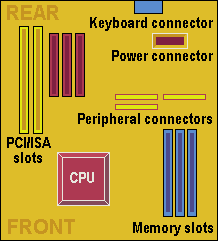The Baby AT (BAT) format reduced the dimensions of the motherboard to a typical 9in wide by 10in long, and BAT motherboards are generally characterised by their shape, an AT-style keyboard connector soldered to the board and serial and parallel port connectors which are attached using cables between the physical ports mounted on the system case and corresponding connectors located on the motherboard.

With the BAT design the processor socket is located at the front of the motherboard, and full-length expansion cards are intended to extend over it. This means that removing the processor requires the removal of some or all expansion cards first. Problems were exacerbated by the increasing speeds of Pentium-class processors. System cooling relied on the AT power supply blowing air out of the chassis enclosure and, due to the distance between the power supply and the CPU, an additional chassis fan or active heatsink became a necessity to maintain good airflow across the CPU. AT power supplies only provide 12V and 5V outputs to the motherboard, requiring additional regulators on the motherboard if 3.3V components (PCI cards or CPUs) are used. Sometimes a second heatsink was also required on these voltage regulators and together the various additional heat dissipation components caused serious obstruction for expansion slots.
Some BAT designs allow the use of either AT or ATX power supplies, and some ATX cases might allow the use of a Baby-AT motherboard.
- Evolution of the motherboard
- BIOS – What motherboard BIOS does for a PC
- CMOS – complementary metal oxide silicon – RAM chips on motherboards
- EFI – Extensible Firmware Interface – explained
- Motherboard form factors
- Baby AT (BAT) Motherboard Form Factor
- LPX – Low Profile eXtension motherboard form factor
- ATX form factor
- NLX – New Low profile eXtended – form factor for motherboards
- Micro ATX motherboard form factor
- FlexATX motherboard form factor
- BTX – Balanced Technology eXtended – Motherboard Form Factor
- Riser architectures for motherboards
- CPU interfaces – motherboard slots and sockets for AMD and Intel processors